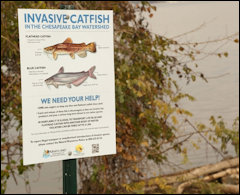Undocumented swimmers. The Chesapeake Bay Watershed has more than its fair share of non-native species. Mute swans escaped from an estate on the Eastern Shore where they had been imported from Eurasia. Today they are the largest birds in the Chesapeake Bay Watershed. Nutria were introduced to a nature preserve in 1943 in the hopes of kick-starting a fur farming industry. Today these waterborne rats eat sediment-holding plants in salt marshes. Phragmites accidentally introduced into the holds of ships now crowd out native marsh plants. In fact, the Chesapeake Bay itself could be seen as an invasive species since it was created about 35 million years ago when a large meteorite hit Earth just off what is today Hampton Roads.
Johnny come latelys. Two invasive species of fish have recently been introduced to the Chesapeake Bay: the Snakehead and the Blue Catfish. Snakeheads were introduced after being purchased as aquarium fish and then discarded in local waterways. Long and large with conspicuous teeth, the snakehead has caused quite a sensation. They now occupy at least 60 river miles of the Potomac River. After an explosive start recent evidence suggests that the snakehead population might be leveling off or even declining slightly. Not only do largemouth bass (another invasive species in the Potomac River) enjoy an occasional breakfast of snakehead fry but people have found the “Potomac Pike” to be fun to catch and delicious as well. Governor Northam’s signing of a law that will allow the sale of Snakehead meat ought to help keep the toothy predator in check.
Stupid is as stupid does. The most vexing invasive species in the Chesapeake Watershed wasn’t introduced by accident or by some World War II brain cramp intended to spur fur farming. No, it was a deliberate act during the 1970s designed to improve sport fishing in Virginia. The environmental wizards of the day saw no issue with introducing an apex predator which can grow to over 100 pounds. At the time of the Blue Catfish introduction, I suppose horribly polluted rivers such as the James could allow only a few nearly indestructible fish species like Blue Catfish to thrive. And thrive they did. Today, Blue Catfish surveys indicate that the total fish biomass of large sections of the James River is 50% or more Blue Catfish.
So, can we turn the Blue Catfish into the equivalent of the Snakehead (aka the Potomac Pike) – a tasty treat? Blue Cats are large, plentiful and delicious. They are easy to catch and abundant in rivers like the James. However, one may want to think twice before ordering the Blue Cat Blue Plate Special at Bookbinders. It seems that Richmond’s efforts to clean up the James have been …. well … spotty. A recent survey of Blue Catfish stomach contents from catfish caught in the James near Richmond produced tampons, condoms and human feces. In fairness to River City I’m not sure that I’d eat Blue Catfish caught near Alexandria either. What a sad state of affairs.



